| March 2022 | | | February saw a team of our girls take to the stage for the 'Stars of Orange Dance for Cancer'. What a wonderful performance! Some of the team went along to support the girls and the worthy cause.
The wet weather has seen a surge in skin issues for thick coated dogs in particularly. Keep them well groomed to minimise the problems. | | | Orange Vet Hospital |
|
|
 | | Pet breathing difficulties | | | Pet breathing difficulties (also known as dyspnoea) can indicate a serious issue, and may be distressing for both the affected pet and their owner.
What are some common causes of pet breathing difficulties?
Dyspnoea in pets can be caused by:
- Airway issues, e.g. brachycephalic (flat-faced) dog breeds experiencing a sudden worsening in their breathing due to excessive heat or stress
- Lung problems, e.g. congestive heart failure (where the lungs fill with fluid due to poor heart function), or pneumonia
- Chest problems, e.g. trauma or rat bait poisoning causing bleeding within the chest cavity
Problems such as tick paralysis can impair the function of the airways, lungs and chest simultaneously.
What should I do if my pet is having trouble breathing?
If your pet is showing signs of breathing difficulties, it’s always best to have them assessed urgently, whatever the time of day. Please phone our clinic asking to have your pet seen as an emergency appointment.
If your pet is choking, carefully check their throat (if it’s safe enough to do so) and try to remove the foreign object, and seek veterinary attention as quickly as possible.
On the way to your appointment, try to keep your pet calm. Keep the car cool with high air-conditioner fan flow. Do not shower your pet.
Once your pet reaches the clinic, our veterinary team will assess the animal and provide them with supplementary oxygen and assess them further and other treatment as needed. |
|
|
 | | Tummy troubles | | | When our pets are suffering from an upset tummy, we empathise with them and want to relieve their troubles as soon as possible (even if we’re pretty sure their symptoms are the result of some cheeky food scrap stealing). However, it can sometimes be hard to know when to just support them with TLC at home, and when they actually require urgent veterinary care to treat their tummy woes.
Here are some indications that a prompt veterinary assessment is recommended for your pet’s gastrointestinal issues:
Your pet is lethargic
If your pet is lethargic, they may be uncomfortable, require pain relief and/or anti-nausea medications.
For those pets displaying more severe lethargy, this can also indicate that your pet is becoming dangerously dehydrated, or is affected by a more significant illness requiring urgent treatment.
Your pet is a young puppy or kitten, or an older animal with chronic health issues
Whilst healthy adult animals have some ability to cope with a routine gastrointestinal upset, very young or chronically unwell pets can have reduced coping strategies, and a lower immune capacity. These pets can also become dehydrated or develop metabolic imbalances much more easily, which may cause a rapid deterioration in their condition.
Your pet is bringing up blood
If your pet is vomiting or pooing fresh or digested black/brown or red blood, urgent veterinary care is recommended.
You suspect your pet has eaten something they shouldn’t have
If you think your pet has eaten something potentially toxic (e.g. xylitol, rotten garbage or human medications) or something that could cause a blockage, phone our team for urgent advice. Time can be of the essence when treating these conditions.
Your pet’s symptoms aren’t settling within 24 hours
This indicates that further veterinary assessment and treatment may be required for a more significant illness.
If you are worried about your pet!
If you are simply concerned about your pet, please don’t hesitate to phone our friendly team. We’re always happy to help! |
|
|
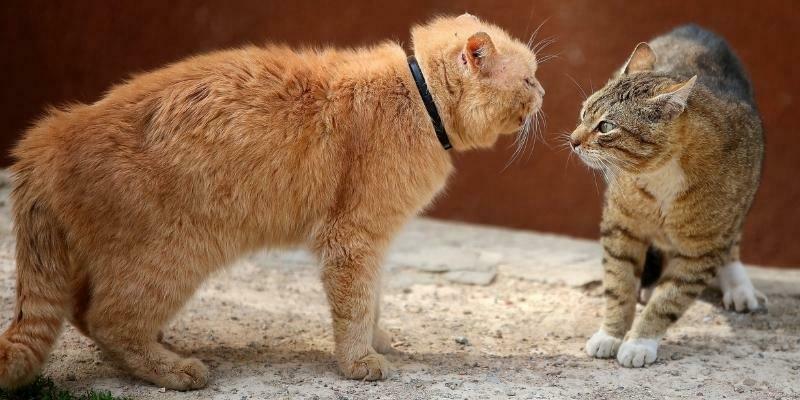 | | A sharp warning | | | Like us, animals don’t always get on with each other! Unfortunately, the results of their disagreements can range from a warning nip to a full-blown attack or fight. As well as being traumatic and upsetting for the pets involved (and us as owners), dog and cat bites can also create nasty injuries.
When a dog or cat bites with intent, their long sharp canine teeth can penetrate deeply into the victim’s tissues.
In the case of dog bites, their powerful jaws can cause significant tissue bruising, crushing or tearing. Even with relatively simple-looking skin puncture wounds, it’s recommended to have a veterinarian assess the wounds, as:
- With some bites, areas of skin may be separated from the deeper muscle tissue that it normally attaches to, creating an internal “pocket” that can easily become infected
- Significant crushing damage can result in dangerous swelling (particularly around the throat) and can affect the blood supply to nearby tissues, resulting in a larger wound
Whilst cat bites tend not to cause large wounds, their sharp teeth can act like needles, “injecting” nasty mouth bacteria deep into the bitten animal’s tissues. This means that cat bite wounds very frequently develop infections, and can easily become large painful abscesses requiring surgical drainage. Cat fights can also share infectious diseases, for example, Feline Immunodeficiency Virus. If your cat is outdoors where fights can occur, we recommend vaccinating your cat for FIV; ask our vet team how to set this up.
If your pet has been bitten badly enough to break the skin, we advise contacting our clinic to request a prompt appointment, so that we can provide your pet with pain relief, and assess and treat their wounds as appropriately. Similarly, if you or a family member has been bitten in the afray, we recommend you consulting your doctor, pharmacist or the emergency department, as appropriate.
If your pet has been attacked and has gaping wounds or wounds that are steadily dripping blood, or if they seem to be lethargic or in significant pain, contact our team to request an urgent assessment.
With the correct support and veterinary treatment, we can help bitten pets recover from their injuries as comfortably and smoothly as possible. |
|
|
 | | Dietary indiscretion | | | Uh oh, your pet has just stolen and eaten something they shouldn't have… What should you do?
If you think that your pet may have eaten something potentially toxic, it’s always best to seek veterinary advice as soon as possible. Time can be of the essence when treating poisoning cases, with prompt therapy often minimising symptoms and reducing overall treatment costs.
What are some common toxicities in pets?
Common toxicities seen in dogs and cats include:
- Chocolate
- Lily toxicity in cats
- Human medications, such as ibuprofen
- Rat bait
- Xylitol - an artificial sweetener; eg in baked goods, chewing gum, sugar-free drinks
- Sultanas, grapes or raisins- like the dog eating the Sultana Bran, or nomming Christmas Cake
What can we do to help poisoned pets?
When seeking initial veterinary advice for your pet, it’s helpful if you can have the packet (or a photo) of what your pet has eaten close to hand (so you can read out the label to us), and an estimated amount that your pet could have consumed (i.e. was it full or was it half full?).
If your pet has eaten the toxic substance within the last 2-4 hours, we may discuss potentially making them vomit or flushing out their stomach under anaesthetic, to rid them of any undigested material and limit toxin absorption.
If it’s too late or unsafe to empty your pet’s stomach, or if they’re already showing symptoms, we will discuss ongoing treatment for their condition. Depending on the particular toxin, this can include:
- Feeding them activated charcoal to help “bind up” toxin in their intestines (note: this only works with some substances)
- Hospital care, including intravenous fluid support or medications to manage your pet’s symptoms
- Administration of any relevant antidotes, e.g. Vitamin K1 for rat bait poisoning
- Regular blood tests to monitor your pet’s health
With prompt veterinary treatment, we can improve the chance of your pet making a full, rapid recovery. Unfortunately, we haven’t yet mastered the art of teaching them not to do something silly again! |
|
|
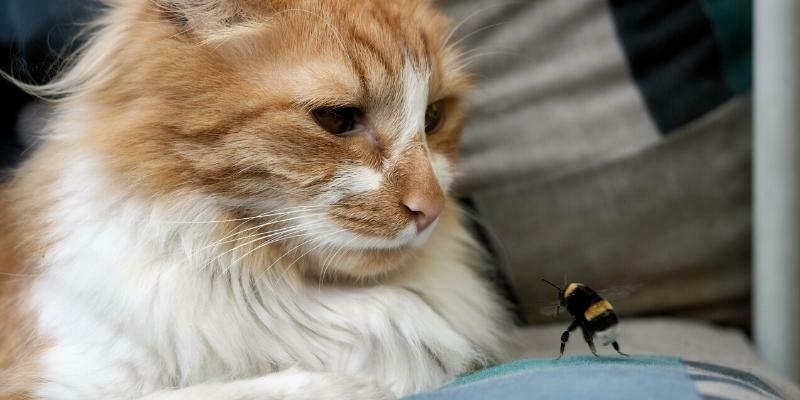 | | A sting in the tail | | | Bees are sometimes colloquially referred to as “spicy sky raisins”, because our curious pets are often drawn to snap at or play with these buzzing insects, and can unfortunately pay a rather painful price as a result!
What will happen to my pet if they get stung by a bee?
Symptoms of a bee sting in pets can involve localised or generalised reactions, with localised being the most common.
Localised reactions involve pain at the site of the sting, with surrounding tissue redness and swelling - similar to what most of us would experience with a bee sting.
Generalised bee sting reactions can range from milder allergic-type symptoms (such as itchiness and red skin lumps around your pet’s body), or serious anaphylactic reactions. Anaphylaxis occurs if your pet has a severe allergic response to the bee venom, and can cause affected pets to develop sudden vomiting, diarrhoea, collapse or breathing difficulties, or even respiratory arrest.
What treatment will my pet require for a bee sting?
If you suspect your pet has been stung by a bee, but they seem generally OK (other than being sore at the sting site), you can start treatment at home by carefully removing any embedded stinger, placing a cold compress on the area and monitoring your pet closely for 12-24 hours. However, if your pet seems to be in a lot of pain, or having any breathing difficulties, it’s important to seek urgent veterinary attention as anaphyllaxis treatment, pain relief and antihistamine medication may be required.
If your pet seems generally uncomfortable or is showing any signs of unwellness, we recommend an urgent consultation so that our vets can assess them further and administer treatment as required to support their safe recovery.
Remember that we are available after hours by calling through the regular phone number- this is staffed by a veterinarian, so do leave a message in case they are tied up with another patient, and remember NOT to call for non-emergencies- let them sleep! |
|
|
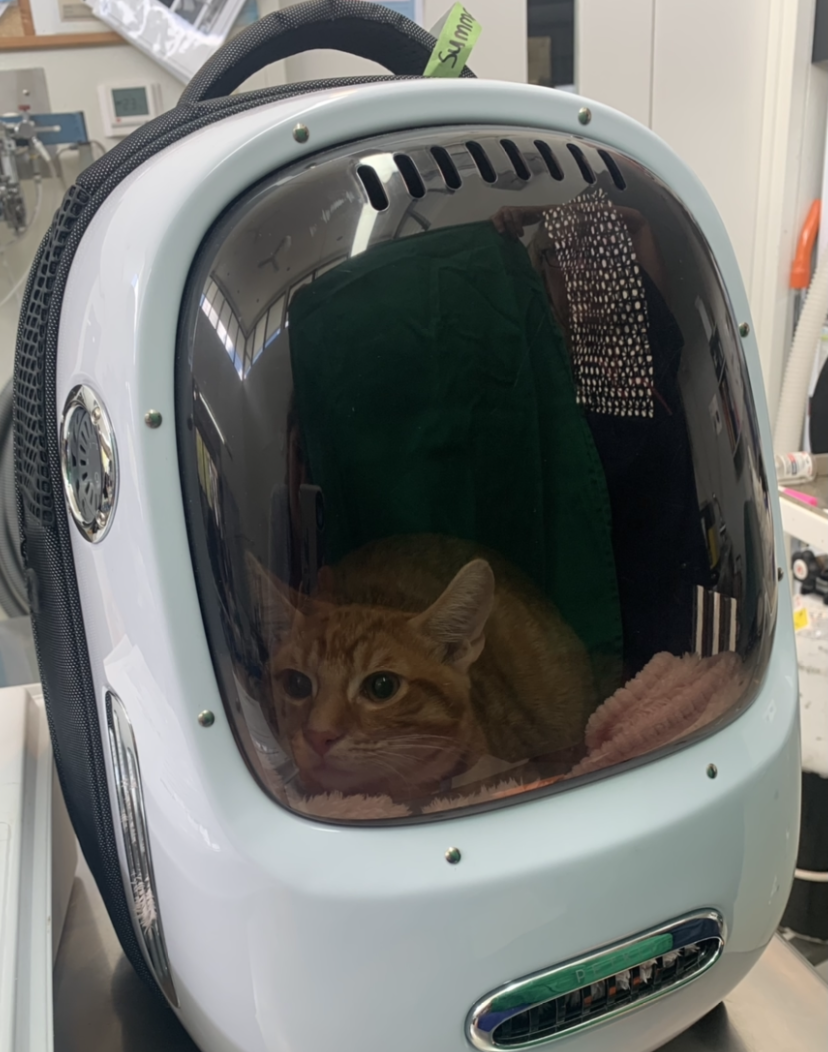 | | Cat containment | | | Remember to keep your cat safely secured coming into the clinic. Use a cat carrier ideally, or a harness and leash, or even a secure box. Here above is Summer, who came in safely and stylish in this space styled container. We hate trying to catch loose cats on Molong Road, because we know they are in danger! |
|
|
 | | Patience is a virtue | | | Like many vet clinics, we have had a big influx in caseload through the COVID period. We have added extra vets- but scheduling is still tricky.
Higher workload
Veterinary clinics in many areas of the world have reported an increase in demand for consultations and medical/surgical care of pets. This is due to:
* More new pets – many people decided to adopt or buy a pet during the COVID-19 pandemic. According to the latest Animal Medicines Australia survey, 69% of households own a pet, up from 61% in 2019. This has created more puppy and kitten checks and vaccination appointments, and more routine surgeries such as desexings.
* Increased owner awareness – with more people working from home than ever, pet owners have spent more time hanging out with their furry family members. This has resulted in increased pet owner awareness of their pet’s normal and abnormal behaviours, and increased recognition of health problems.
The Australian Veterinary Association is asking all pet owners to be thoughtful, respectful and patient towards veterinarians as they deliver the necessary care to your pets. Pet owners can assist both their pet and their vet by being prepared - by checking your local vet clinic’s opening hours, and in all cases - ringing ahead to alert the vet practice that you are on your way. Be prepared for longer than usual wait times at veterinary practices, and book your pet's needs in advance.
Please be kind to the receptionists when you call or attend- lately there have been huffy clients when their requests are not met. Use kindness, tolerance, and flexibility- we are all doing our best. Rest assured, we would not recommend a vet if they were not up to the task at hand. Just because we can't arrange THE vet that you want at THE time that you want to coincide with the lunar phase you request, we WILL try to help you as best as appropriate.
How can you help?
* Book ahead for routine appointments, like vaccinations and desexings. Think ahead to Easter now if you are going away- remember that pets will need to be up to date to go in for boarding.
* Request medication refills in advance. Plan for 4 days for regular medications, and at least a week for compounded medications, like behaviour medications and some thyroid medications. Every medication request has to be checked by a veterinarian for approval to keep your pet safe.
* Be flexible with pet food shortages: we don't manufacture this and are working hard to have your pet's needs met.
* Bring your patience, your pet's vaccination records, and empathy for other human beings when you visit the vet.
Remember that we are available after hours by calling through the regular phone number- this is staffed by a veterinarian, so please DO leave a message in case they are tied up with another patient, and remember NOT to call for non-emergencies- let them sleep! Vets are human too, and must work the following day. Vets are happy to attend for genuine emergencies, but are less than thrilled to be woken to discuss your pet's dietary needs or book a revisit at 3am.
See the link below to see the AVA's media release on the topic. |
|
|
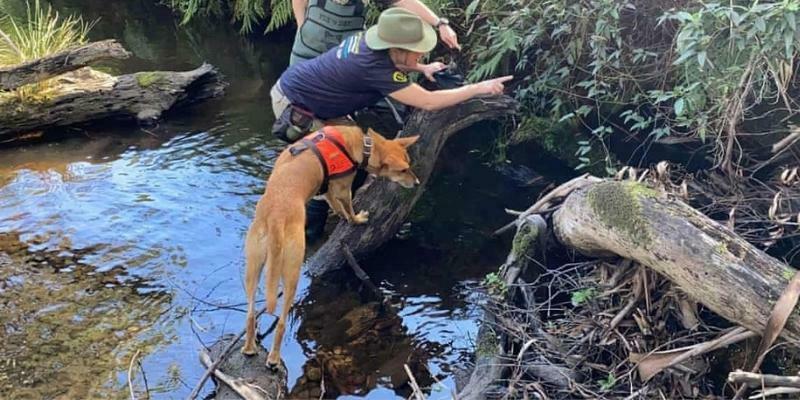 | | Animal News In Brief | | | Kip in training
Image source: The Guardian
Sniffer dogs now detecting… platypuses!
Despite being a national treasure, it’s intriguing how little we know about the platypus. In the interest of platypus conservation, Zoos Victoria have been training Kip, a six-year-old kelpie cross, to detect and locate wild platypuses in order to gain critically-needed population data. Working alongside Kip is wildlife detection dog officer Naomi Hodgens, who will ensure Kip can follow the platypus scent and persevere through challenging environments, while avoiding any disturbance to our duck-billed friends. Once Kip finds a burrow occupying a platypus, his training will have him sit a respectful distance away and alert his handler, who will hand him a treat. In January 2021, the Victorian government marked the platypus as a threatened species, and due to their dark colouring, darkly-lit habitats and the fact that they’re nocturnal, platypuses aren’t easy for humans to track, which makes population data hard to uncover and conservation very tricky. In April, however, Kip will graduate out of training and bring his skills into the wild. Although to Kip, this work may just seem like “a big game” according to Hodgens, this very good detection doggo is helping to increase our understanding of the platypus, kindling a national hope in protecting these incredible, yet vulnerable, critters.
Read more about Kip’s project from The Guardian.
-----
Calls to make exercising pets a legal requirement, everywhere
We know animal cruelty exists, but it’s not often talked about how cruelty can be caused by something as casual as not making time to walk your dog. When a dog is locked inside all day, they don’t just miss out on vital exercise, but also the sensory stimulation they receive from socialising and exploring surrounding environments. In March last year, the Australian Capital Territory enshrined pet walks into law, with a $4,000 fine for pet owners who neglect to walk, feed or provide water for their pet. Now, animal welfare campaigners are calling on other states and territories to consider similar penalties. “A lack of socialisation is emotionally damaging, it can make a dog fearful, aggressive and hostile towards other dogs and people,” said Rebecca Linigen, National Director of FOUR PAWS Australia. “If this law does create a positive impact on animal welfare, and preventing animal neglect, then it’s something we should all support.” This legal shift in ethically supporting the welfare of our furry friends is happening not just in Canberra, but around the world, with Norway recently taking a stand against the selective breeding of certain pets, such as bulldogs, who endure a life of ‘man-made health problems’.
Read more about the ACT fine from Daily Mail.
-----
As climate change intensifies, pets simply cannot handle the heat
Heatstroke in pets can be prevalent in the warmer months, but as a new study by Nottingham Trent University reveals, the condition is only going to become more common due to the effects of climate change. "Heat-related illness can affect all pets and is likely to become more common as global temperatures rise," said researcher and veterinarian Emily Hall. Climate change is impacting everything, and that means that as the days get hotter, we must adjust our animals’ environments. Researcher Dr Anne Carter stresses that the issue is not just about “dogs in hot cars”. Guinea pigs, rabbits, ferrets and cats can all be affected, while dogs with flat faces are especially vulnerable. However, by keeping a watchful eye over our pets, ensuring they have cool, shady spaces to occupy with plenty of fresh water and aren’t outside in the hottest parts of the day, heatstroke can be prevented. Pets with heatstroke can display symptoms of abnormal breathing, lethargy, collapse and gastrointestinal issues, such as diarrhoea. If you notice your pet showing any of these symptoms, bring them in to see us immediately!
Read more about the effect of heatstroke on pets from the BBC. |
|
|
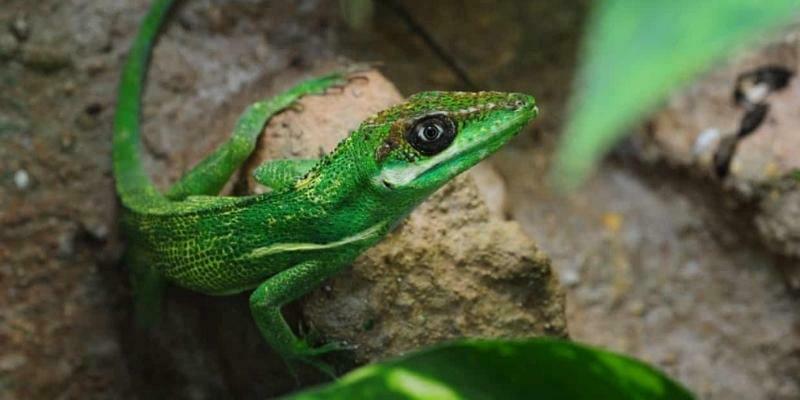 | | Survival of the fittest: the animals adapting to climate change | | | The "hurricane lizard"
Image source: The Guardian
Evolution is a fickle thing. When the environment changes, species must adapt to these changes to avoid extinction - this is called plasticity. From changing breeding seasons to changes to access to food sources, species plasticity shifts (both physical and behavioural changes) are being recognised across the globe.
When a region gets too hot, animal species must find cooler regions to survive. This is evident in an article from Mongabay, that reveals how mountain-adapted species are having to move to even higher altitudes, as the warming world decreases habitat space.
Phenological shifts (the seasonal timing of biological events) are also being observed, with mother grey seals birthing their pups earlier in the breeding season, but at an older average age. The Royal Society explains that, “grey seals accumulate resources for breeding during the majority of the year and then do not forage while suckling their pups,” so, as sea conditions become affected by the climate and resources become limited, a more competitive resource demand is put on seal mothers trying to feed their young.
A new movement in food sourcing has become apparent too, with Alaskan bears opting for early-ripening elderberries to supplement the nutrients missed from their usual salmon diet.
And species themselves are changing.
Usually territorial aggressors, butterflyfish have altered their evolutionary behaviour, becoming more pacifist to conserve energy and survive on nutrient-depleted reefs.
While the humboldt squid have been maintaining their population and combating marine heat waves by shrinking in size and shortening their life spans.
Similarly, Amazonian birds have, each decade, shrunk as much as 2% of their body weight since 1980 to more effectively dissipate heat. Caribbean Anole lizards have evolved their toe pads to a greater size to increase their gripping strength when holding onto trees and shrubs amidst more commonly-occurring hurricanes.
Although many species are demonstrating plasticity to adapt to the current, already-warmed climate, sadly, many species will simply not be able to. Conservation resources are limited, so understanding which species can conform to a changing climate is crucial. As The New Statesman article articulates, “we simply cannot save everything.”
Read more about the impacts of climate change on species from Brightly, ABC News and The Guardian |
|
|
This email contains comments of a general nature only and is not intended to be a substitute for professional veterinary advice. It should not be relied on as the basis for whether you do or don't do anything.
All content © PetPack 2022 |
|
|
This email was sent to:
email@example.com
Orange Veterinary Hospital
57 Molong Rd
Orange, NSW 2800
|
|
|
|